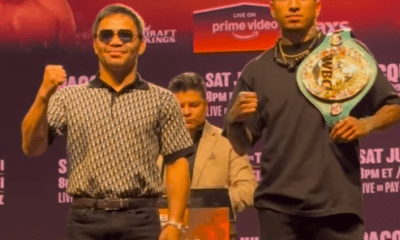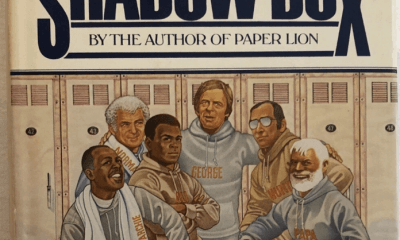Featured Articles
Is Ana Julaton The One?
Ana “The Hurricane” Julaton (12-3-1, 2 KOs) faces upset-minded Celina Salazar (4-1-2, 1 KO) on August 17 in Cancun Mexico. The Golden Boy promoted bout will be broadcast live on Televisa in both the United States and Mexico.
Salazar, 24, lives and trains in San Antonio, Texas and has been fighting professionally since April 2009. She is trained by Arturo Ramos. Julaton, 33, said she didn’t know much more about her opponent than that, but that she’d know plenty about her after the bell rings on fight night. She told TSS her trainer, Angelo Reyes, was the one who watched tapes of opponents and set up the game plan. It’s her job, then, to follow it.
“I’ve been pushing hard in sparring and working on all the stuff that’s in the game plan. I’m just working hard. My team has been pushing me hard. I can’t wait until all that’s over now, so I can get in the ring.”
Reyes and Julaton have been working together since the Filipino-American was an amateur. Still, Julaton said she and her trainer had augmented her repertoire through the years by working with some of the best boxing minds in the sport, including Nonito Donaire Sr. and Freddie Roach.
Julaton said working with different coaches is both difficult and challenging.
“It’s difficult at first. It’s intense when you have your own basics and ideas about how boxing should work. When I started working with different trainers and coaches to implement different things here and there, it just took a lot of time. But as time went on, I got better at translating ideas. I understand my body a bit better and different pacing.”
Julaton said she feels like she’s at her absolute peak now, and the timing couldn’t be better. She is rumored to be Showtime’s preferred headliner whenever the television giant decides to give women’s boxing a go, which could be as soon as the undercard of Mayweather vs. Canelo.
If Julaton does end up being the one to put women’s boxing back on the map, it won’t just be because of her impressive work inside the ring. No, Julaton is as media savvy as they come, as evidenced by the blitzkrieg of attention she’s received in the buildup to Saturday night’s fight.
And that’s by design. Julaton likens her outside-the-ring strategy to what she employs inside of it when the bell rings.
“Just like with boxing, you can’t just focus on the first round. In a ten-round fight, you have to focus on all ten rounds. Just like in the business of boxing, you have to have a plan for the beginning, the middle and the end.”
Clearly, she knows what it takes to get the job done.
“You have to be savvy. You have to be smart. You have to think ahead.”
Not too far ahead, of course. Julaton said despite the ever growing rumors of her fighting on Showtime, she’s remained as focused as ever. Still, she can’t help but be excited about the possibility.
“I think it would be an opportunity to finally show the United States what my life has like been since the beginning. I’m up for any fight. They could have put anyone in front of me on August 17 and I was going to be ready to go all out for ten rounds. I’m treating it like a title fight. To have a shot at Showtime? I’m going back to the basics. It all starts with the fight on August 17. Everything else is just secondary. I think it would be a big boost [for women’s boxing], a big lift, but it’s not the biggest focus on my mind.”
Julaton says it will take more than just one person to bring women’s boxing out of the shadows.
“It takes a collection of fighters. You need people to know you and talk about you as a fighter. But if they don’t have the ‘anti-you”[e.g., the Frazier to her Ali] it’d be hard to keep that momentum going.”
Likewise, Julaton said it’s taken a collection of individuals working towards the same goal to get her where she is today. In the end, Julaton said that’s what it’s all about. Her relationship to Reyes as well as manager Allan Tremblay is paramount.
“It takes more than one person. I feel like you need a really good, strong, passionate and supportive base all working towards the same goal. I just have a super, super team: Allan, Angelo and Ana. Call us the Super A team!”
It’s who she fights for, Julaton told TSS, and it’s who inspires her the most. Julaton speaks passionately about almost everything, it seems, but she’s particularly full of emotion when it comes to her team. Reyes has told her from the beginning, she says, that women’s boxing would one day be featured in the United States like it is elsewhere. And Tremblay, she says, went above and beyond in his support of her as a manager, all the while battling cancer.
“To see Allan deal with cancer for as long as he’s been dealing with it….can you imagine battling for your life for years but always carrying a smile and a positive attitude? It’s amazing! And Angelo Reyes…talk about me dealing first hand with people being sexist and having people not believing in me…well it’s pretty cool to have someone who is not like that, who believes in you so much that he’ll fight for you, too.”
Julaton’s voice cracks a bit. She’s acts as if she’s clearing her throat, but then decides the gig is up.
“Sorry, I get really choked up about it. I get so intense about it because I believe it. It just flows in me.”
Showtime or not, it seems Ana Julaton has made it. Here she is, surrounded by a loving, supportive team that truly have her best interests at heart, doing the one thing she loves most in the world.
“I’m lucky to say that boxing is my fulltime job. It’s something I never thought about as a kid, being a boxer, but I was a martial arts fanatic and I never wanted to leave it. I never wanted to do what other people do. I just always wanted to be around the fighting arts. There’s just something beautiful about it, something that struck me. I just connect to it. And I’m able to do that with this sport.”
And the secret to her success?
“In boxing, you’ll never stay stagnate if you just keep moving.”
And so she does.
Follow @KelseyMcCarson on Twitter.
-

 Featured Articles3 weeks ago
Featured Articles3 weeks agoAvila Perspective, Chap. 330: Matchroom in New York plus the Latest on Canelo-Crawford
-

 Featured Articles1 week ago
Featured Articles1 week agoVito Mielnicki Jr Whitewashes Kamil Gardzielik Before the Home Folks in Newark
-

 Featured Articles4 weeks ago
Featured Articles4 weeks agoAvila Perspective, Chap 329: Pacquiao is Back, Fabio in England and More
-

 Featured Articles3 weeks ago
Featured Articles3 weeks agoOpetaia and Nakatani Crush Overmatched Foes, Capping Off a Wild Boxing Weekend
-

 Featured Articles2 weeks ago
Featured Articles2 weeks agoCatching Up with Clay Moyle Who Talks About His Massive Collection of Boxing Books
-

 Featured Articles3 weeks ago
Featured Articles3 weeks agoFabio Wardley Comes from Behind to KO Justis Huni
-

 Featured Articles1 week ago
Featured Articles1 week agoMore Medals for Hawaii’s Patricio Family at the USA Boxing Summer Festival
-

 Featured Articles4 weeks ago
Featured Articles4 weeks agoDelving into ‘Hoopla’ with Notes on Books by George Plimpton and Joyce Carol Oates















